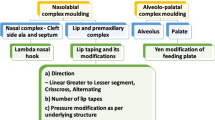Abstract
Introduction
Primary cleft lip repair techniques do not address the nasal deformity adequately resulting in nasal asymmetry. Maneuvers employed to minimize this have varying degrees of success.
Aim
To assess the outcome of different treatment modalities employed to establish nasal symmetry in unilateral cleft lip.
Methods
100 patients with complete unilateral cleft lip/ palate operated for primary cheiloplasty with modified Millard’s rotation advancement technique were divided into five groups. Group 1: lip repair alone, Group 2: NAM followed by lip repair, Group 3: lip repair followed by placement of conformers, Group 4: NAM followed by lip repair and placement of conformers, Group 5: lip repair with semi-open rhinoplasty. Objective assessment was done using measurable parameters after 12 months post-operatively on a 1:1 standard photograph.
Results
Group 5 showed statistical significance in all parameters assessed. Progressive improvement in nasal symmetry was noted from Group 1 to Group V.
Conclusion
In our study, group V, i.e., modified Millard’s repair with semi-open rhinoplasty improved the results in terms of all the objective parameters assessed. The results of the other groups showed improvement though not consistent in all parameters. Naso-alveolar molding is an effective adjunct. Additionally, nasal conformers proved to be of great value in retaining the results obtained post-surgery.





Similar content being viewed by others
References
Sundine M, Phillips J (2004) Treatment of the unilateral cleft lip nasal deformity. J Craniofac Surg 15(1):69–76
Salyer KE, Genecov ER, Genecov DG (2004) Unilateral cleft lip-nose repair—long-term outcome. Clin Plast Surg 31(2):191–208
Arajy ZY, Nawres AM (2009) Primary repair of unilateral cleft lip nasal deformity. Iraqi Postgrad Med J 8(3)
Li AQ et al (2002) Anatomy of the nasal cartilages of the unilateral complete cleft lip nose. Plast Reconstr Surg 109(6):1835–1838
Demke JC, Tatum SA (2011) Analysis and evolution of rotation principles in unilateral cleft lip repair. J Plast Reconstr Aesthet Surg 64(3):313–318
Somensi RS, Giancolli AP, Lucenade F (2012) Assessment of nasal anthropometric parameters after primary cleft lip repair using the Mohler technique. Rev Bras Cir Plást 27(1):14–21
Adenwalla HS, Narayanan PV (2009) Primary unilateral cleft lip repair. Indian J Plast Surg 42(Suppl):S62–S70
Markus AF, Delaire J (1993) Functional primary closure of cleft lip. Br J Oral Maxillofac Surg 31(5):281–291
Gawrych E, Janiszewska-Olszowska J (2011) Primary correction of nasal septal deformity in unilateral clefts during lip repair—a long-term study. Cleft Palate Craniofac J 48(3):293–300
Armstrong GT et al (1997) A modification of the primary nasal correction in the rotation-advancement unilateral cleft lip repair. Ann Plast Surg 38(3):236–245
Chow V, Chen P, Noordhoff S (1999) The use of nasal splints in primary management of unilateral cleft nasal deformity. Plast Reconstr Surg 103(5):1347–1354
Thomas C, Mishra P (2000) Open tip rhinoplasty along with the repair of cleft lip in cleft lip and palate cases. Br J Plast Surg 53(1):1–6
Grayson BH et al (1999) Presurgical nasoalveolar molding in infants with cleft lip and palate. Cleft Palate Craniofac J 36(6):486–498
Barillas I et al (2009) Nasoalveolar molding improves long-term nasal symmetry in complete unilateral cleft lip–cleft palate patients. Plast Reconstr Surg 123(3):1002–1006
Matsuo K, Hirose T (1991) Preoperative non-surgical over-correction of cleft lip nasal deformity. Br J Plast Surg 44(1):5–11
Nakajima T, Yoshimura Y, Sakakibara A (1990) Augmentation of the nostril splint for retaining the corrected contour of the cleft lip nose. Plast Reconstr Surg 85(2):182–186
Tse R (2013) Unilateral cleft lip: principles and practice of surgical management. Semin Plast Surg 26(04):145–155
Raymond B, Sudjatmiko G (1970) Self made nostril retainer. Jurnal Plastik Rekonstruksi 1(2)
Dhanraj P (1994) The use of a suction tube as a nostril retainer. Plast Reconstr Surg 93(3):643–644
Ozgur F, Tuncali D, Kayýkcýoglu A (1999) Securing the nostril retainer. Plast Reconstr Surg 104:1328
Li J et al (2011) A photogrammetric study of the effects of alveolar bone graft on nose symmetry among unilateral cleft patients. J Plast Reconstr Aesthet Surg 64(11):1436–1443
Pai BCJ et al (2005) Symmetry of the nose after presurgical nasoalveolar molding in infants with unilateral cleft lip and palate: a preliminary study. Cleft Palate Craniofac J 42(6):658–663
Acknowledgments
Authors would like to thank Kanachur Institute of Medical Sciences and Center for Craniofacial anomalies, Yenepoya University for the encouragement and facilities provided. Authors would also like to thank Dr Srikant N for helping with the statistics.
Funding
This research did not receive any specific Grant from funding agencies.
Author information
Authors and Affiliations
Corresponding author
Ethics declarations
Conflict of interest
The authors declare that they have no conflict of interest.
Ethical Approval
The manuscript was cleared by Institutional review board for publication and study was performed in line with the principles of the Declaration of Helsinki.
Consent to Participate
Informed consent was obtained from the parents of all individual participants included in the study.
Additional information
Publisher's Note
Springer Nature remains neutral with regard to jurisdictional claims in published maps and institutional affiliations.
Rights and permissions
Springer Nature or its licensor (e.g. a society or other partner) holds exclusive rights to this article under a publishing agreement with the author(s) or other rightsholder(s); author self-archiving of the accepted manuscript version of this article is solely governed by the terms of such publishing agreement and applicable law.
About this article
Cite this article
Mustafa, K., Fatima, S., Ashith, M.V. et al. Treatment Modalities to Achieve Nasal Symmetry in Unilateral Cleft Lip/Nasal Deformity: An Objective and Comparative Evaluation. J. Maxillofac. Oral Surg. 22, 930–937 (2023). https://doi.org/10.1007/s12663-023-02039-7
Received:
Accepted:
Published:
Issue Date:
DOI: https://doi.org/10.1007/s12663-023-02039-7




